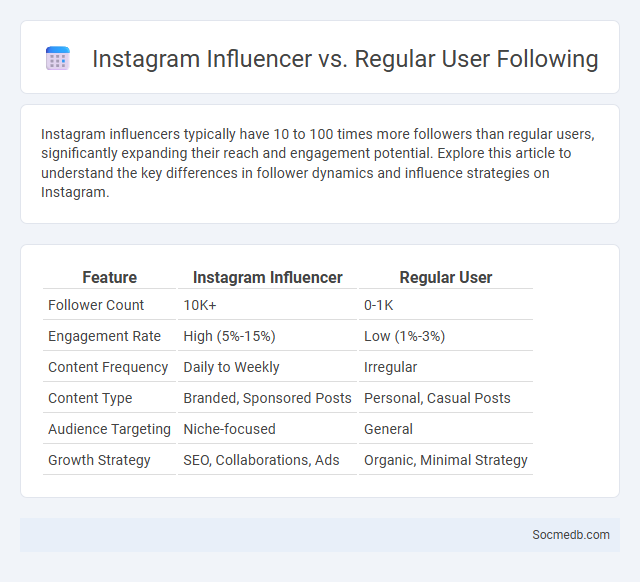
Photo illustration: Instagram Influencer vs Regular User Following
Instagram influencers typically have 10 to 100 times more followers than regular users, significantly expanding their reach and engagement potential. Explore this article to understand the key differences in follower dynamics and influence strategies on Instagram.
Table of Comparison
| Feature | Instagram Influencer | Regular User |
|---|---|---|
| Follower Count | 10K+ | 0-1K |
| Engagement Rate | High (5%-15%) | Low (1%-3%) |
| Content Frequency | Daily to Weekly | Irregular |
| Content Type | Branded, Sponsored Posts | Personal, Casual Posts |
| Audience Targeting | Niche-focused | General |
| Growth Strategy | SEO, Collaborations, Ads | Organic, Minimal Strategy |
Understanding Instagram Influencers vs Regular Users
Instagram influencers typically have a large, engaged following and specialize in creating niche content that drives brand partnerships and sponsorships. Regular users generally share personal moments and engage more casually with their network without aiming for professional influence or monetization. Your strategy on Instagram should consider these differences to effectively target or collaborate with the right audience.
Defining "Following" on Instagram: What Does It Mean?
Following on Instagram means subscribing to another user's account to see their posts, stories, and updates in your feed. It helps users stay connected and engage with content by liking, commenting, and sharing. This interaction supports building communities and influences content visibility through Instagram's algorithm.
The Goals of Influencers vs Regular Users on Instagram
Influencers on Instagram primarily aim to build a personal brand, increase follower engagement, and secure partnerships or sponsorships to monetize their content. Regular users typically focus on sharing personal moments, connecting with friends and family, and exploring interests without commercial intent. The distinct goals influence content strategy, frequency of posting, and interaction style on the platform.
Audience Engagement: Influencers vs Everyday Users
Audience engagement on social media varies significantly between influencers and everyday users, with influencers generating higher interaction rates through curated content and established credibility. Influencers leverage brand partnerships and niche expertise to foster loyal communities, resulting in increased likes, comments, and shares. In contrast, everyday users primarily engage through personal networks, creating authentic but smaller-scale interactions that emphasize genuine connections over reach.
Follower Growth Patterns: Influencers vs Regular Users
Influencer follower growth often exhibits rapid spikes driven by viral content, collaborations, and media exposure, whereas regular users typically experience gradual increases through organic networking and consistent posting. Algorithms favor content from influencers, amplifying visibility and accelerating audience expansion compared to average users. Data analysis reveals influencers maintain higher engagement rates and retention, crucial factors contributing to sustained follower growth patterns.
Content Strategies: How Influencers Differ from Regular Users
Influencers leverage targeted content strategies that prioritize niche audience engagement and consistent branding, often using data analytics to optimize post timing and format. Regular users generally share more spontaneous, diverse content without a strategic focus on follower growth or engagement metrics. Influencers also employ storytelling techniques and collaborations to enhance authenticity and expand reach across social platforms like Instagram, TikTok, and YouTube.
Interaction Frequency: Influencers vs Regular User Following
Interaction frequency on social media is significantly higher among influencers compared to regular users, as influencers actively engage with their followers through comments, likes, and direct messages to maintain audience interest. Influencers often experience interaction rates ranging from 2% to 10%, whereas regular users typically have engagement rates below 1%. This disparity stems from influencers' strategic content creation and consistent communication efforts, which foster stronger community bonds and increased social interaction.
Quality vs Quantity: Follower Analysis for Both Groups
Your social media success hinges on understanding the quality versus quantity of followers, as high-quality engagement from a smaller, targeted audience often drives better conversion rates than sheer follower numbers. Analyzing follower demographics, interaction patterns, and content preferences reveals which group delivers more meaningful connections and boosts your brand reputation. Prioritizing genuine followers who actively participate enhances the impact of your social media strategy and long-term growth.
Impact of Following-to-Follower Ratio on Instagram Success
The following-to-follower ratio on Instagram significantly influences user engagement and perceived authenticity, directly impacting account growth and brand reputation. Accounts with balanced ratios tend to attract higher interaction rates and trust from followers, which enhances their visibility via Instagram's algorithm. An optimal ratio signals genuine engagement, increasing opportunities for collaborations and monetization.
Choosing Your Path: Influencer or Regular User Approaches
Choosing your path on social media involves deciding between building a personal brand as an influencer or engaging as a regular user focused on authentic connections. Influencers leverage targeted content, audience insights, and consistent posting schedules to grow visibility and monetize their presence. Regular users prioritize genuine interactions, community engagement, and sharing personal experiences without the pressure of content strategy or metrics.
 socmedb.com
socmedb.com